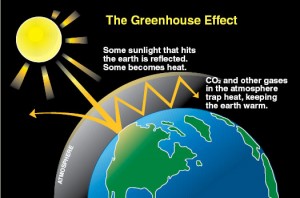Carbon dioxide is a gas produced when burning carbon-based fuels like fossil fuels (i.e., gasoline & diesel). In the atmosphere, CO2 produces a greenhouse effect. The carbon dioxide reflects heat back to the earth, trapping heat on the earth much like glass ceilings trap heat in a greenhouse.

(source: greeningforward.org)
According to climate scientists, levels of carbon dioxide were less than 300 parts per million (ppm) in the atmosphere for the past 800,000 years, up until the advent of the industrial revolution. In the early- to mid-1900’s the concentration of CO2 has risen above 300 ppm and in 2013 the level has surpassed 400 ppm. Due to these CO2 levels along with other greenhouse gases and black carbon soot (see particulate matter), the global average temperature has already risen 1.33°F (0.74°C) in the last hundred years. More than half of this warming, about 0.72°F (0.4°C) has occurred since 1979.
Transportation is one of the largest known contributors to greenhouse gases, accounting for 33% of U.S. CO2 emissions in 2004 (EPA, 2006) and 23% of World CO2 emissions in 2006 (IEA, 2008). Climate scientists predict that the warming of the earth is very likely to bring about increases in extreme weather events, floods, droughts, and sea-level rise (IPCC 2012). Considering the severity of these possibilities, along with their interaction with many other social, economic, and environmental stresses, significant changes are needed in the transportation sector to minimize its contribution to climate change.
What commuters can do to minimize their impact:
- Carpool
- Use public transit
- Ride a bicycle
- Telecommute
- Use a clean energy form of transportation (i.e., hybrid / electric vehicle)

